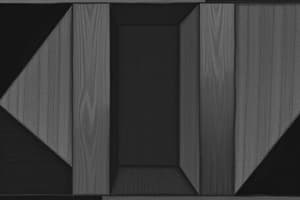Podcast
Questions and Answers
What is the relationship between consecutive interior angles in a parallelogram?
What is the relationship between consecutive interior angles in a parallelogram?
- They are complementary, adding up to 90 degrees.
- They are perpendicular, forming right angles with each other.
- They are congruent, all measuring the same number of degrees.
- They are supplementary, adding up to 180 degrees. (correct)
If the measure of one consecutive interior angle in a parallelogram is $x$ degrees, what is the measure of the other consecutive interior angle?
If the measure of one consecutive interior angle in a parallelogram is $x$ degrees, what is the measure of the other consecutive interior angle?
- $90 - x$ degrees
- $x$ degrees
- $180 - x$ degrees (correct)
- $90 + x$ degrees
Which of the following is true about the relationship between consecutive angles in a parallelogram?
Which of the following is true about the relationship between consecutive angles in a parallelogram?
- Consecutive angles are complementary.
- Consecutive angles are congruent.
- Consecutive angles are supplementary. (correct)
- Consecutive angles are perpendicular.
In a parallelogram, if the measure of one consecutive interior angle is $x$ degrees, what is the measure of the other consecutive interior angle?
In a parallelogram, if the measure of one consecutive interior angle is $x$ degrees, what is the measure of the other consecutive interior angle?
What is the relationship between the consecutive exterior angles of a parallelogram?
What is the relationship between the consecutive exterior angles of a parallelogram?
If the measure of one consecutive interior angle in a parallelogram is $x$ degrees, what is the measure of the other consecutive interior angle?
If the measure of one consecutive interior angle in a parallelogram is $x$ degrees, what is the measure of the other consecutive interior angle?
If a quadrilateral has four congruent angles, what is it called?
If a quadrilateral has four congruent angles, what is it called?
What is the sum of all internal angles in any quadrilateral?
What is the sum of all internal angles in any quadrilateral?
In a rectangle, how many acute angles does it have?
In a rectangle, how many acute angles does it have?
What type of quadrilateral has both pairs of opposite sides parallel and congruent?
What type of quadrilateral has both pairs of opposite sides parallel and congruent?
If the diagonals of a parallelogram bisect each other, what type of shape is it?
If the diagonals of a parallelogram bisect each other, what type of shape is it?
How many types of parallelograms are mentioned in the text?
How many types of parallelograms are mentioned in the text?
Flashcards
Quadrilateral
Quadrilateral
A polygon with four sides and angles.
Properties of Quadrilaterals
Properties of Quadrilaterals
The sum of internal angles is always 360 degrees.
Cyclic Quadrilateral
Cyclic Quadrilateral
A quadrilateral with four congruent angles.
Rectangle
Rectangle
Signup and view all the flashcards
Square
Square
Signup and view all the flashcards
Parallelogram
Parallelogram
Signup and view all the flashcards
Properties of Parallelograms
Properties of Parallelograms
Signup and view all the flashcards
Consecutive Angles
Consecutive Angles
Signup and view all the flashcards
Consecutive Interior Angles
Consecutive Interior Angles
Signup and view all the flashcards
Exterior Angles
Exterior Angles
Signup and view all the flashcards
Sum of Exterior Angles
Sum of Exterior Angles
Signup and view all the flashcards
Polygon Angle Properties
Polygon Angle Properties
Signup and view all the flashcards
Study Notes
Quadrilaterals and Parallelograms
Quadrilaterals and parallelograms are two fundamental concepts in geometry. They share some properties but have distinct characteristics of their own. In this article, we will explore these concepts and discuss how consecutive angles are supplementary.
What is a Quadrilateral?
A quadrilateral is any polygon with four sides. These sides can be different lengths and the angles between them can vary, which allows for many types of quadrilaterals. Some common examples include squares, rectangles, rhombuses, and trapezoids.
Properties of Quadrilaterals
Some general properties of quadrilaterals include:
- The sum of all internal angles in a simple closed figure (a shape without holes) is always equal to 360 degrees.
- If a quadrilateral has four congruent angles, it is called cyclic.
- A rectangle is a special type of quadrilateral that has opposite sides parallel and also has only one acute angle.
- A square is a special type of rectangle in which all sides are equal and all interior angles measure 90 degrees.
What is a Parallelogram?
A parallelogram is a quadrilateral with both pairs of opposite sides parallel and congruent. The diagonals of a parallelogram bisect each other. There are three types of parallelograms: rectangle, square, and rhombus. Rectangle and square are special cases of parallelogram where the opposite sides are congruent.
Properties of Parallelograms
Some specific properties of parallelograms include:
- Both pairs of opposite sides are parallel and congruent.
- The sum of the measures of the interior angles of a parallelogram is always 360 degrees.
- The perimeter of a parallelogram is the sum of all four sides.
Consecutive Angles
In geometry, consecutive angles refer to angles that share at least one side or vertex. These angles can also be classified as either interior angles (angles between two non-adjacent sides) or exterior angles (the angle formed by two adjacent sides when extended infinitely).
Consecutive Interior Angles are Supplementary
One important property of consecutive interior angles is that they are always supplementary. This means their sum is equal to 180 degrees. For example, if there are three consecutive interior angles A, B, and C, such that $A<B$ and $B<C$, then:
[A+B=B+C\Rightarrow A+B+C=2(B)]
Therefore, (A+B+C=180^\circ). This property holds true for any polygon, not just quadrilaterals or parallelograms.
Exterior Angle Measures
The sum of the measures of the exterior angles of a triangle is equal to 180 degrees. The same principle applies to the consecutive exterior angles of any polygon. If we have three consecutive exterior angles D, E, and F, such that (D>E) and (E>F), then:
[D+E=E+F\Rightarrow D+E+F=2(E)]
Therefore, (D+E+F=180^\circ).
This relationship between consecutive angles is an essential concept in geometry and has numerous applications in solving problems involving angular measurements.
Studying That Suits You
Use AI to generate personalized quizzes and flashcards to suit your learning preferences.




